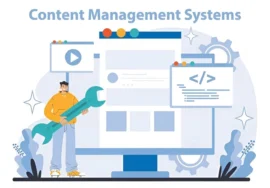
Common Web Development Myths Debunked: Building a Strong Online Presence
The internet landscape is evolving, and with it, the world of web development. This dynamism can be both exciting and overwhelming. Misconceptions can cloud judgment, leading to decisions that hinder the effectiveness of your online presence. Let’s dispel the most prevalent web development myths to equip you with the knowledge needed to craft a robust web strategy.
Myth #1: Websites are one-time tries
Busted: A website is a dynamic entity that thrives on continuous maintenance and updates. Technological advancements occur at a rapid pace, user expectations change and security threats cause ongoing vigilance. Regular attention ensures your website remains performant, user-friendly, and secure. This might include:
Security Updates: Patching vulnerabilities and implementing security measures are crucial to safeguarding your website and user data.
Content Refresh: Keeping content fresh and relevant improves user engagement and search engine rankings.
Performance Optimization: monitoring and optimizing website speed provides a seamless user experience.
Trend Integration: As web design and user meeting (UI) trends evolve, incorporating relevant elements can enhance the overall appeal.
Myth #2: Flash Overact: All I Need is a Dazzling Website
Busted: While esthetics hold undeniable value, the cornerstone of a successful website lies in user experience and functionality. Visitors rank clear navigation, well-structured content, and a design that facilitates achieving their goals. Here’s how to strike the right balance:
Intuitive Navigation: A user-friendly navigation system allows visitors to find the information they seek.
Clear Content: High-quality content that is concise, informative, and appealing is key to keeping visitors engaged.
Focus on User Goals: find the primary objectives visitors have on your website and design the user’s journey to ease accomplishing them.
Myth #3: Mobile Responsiveness is a Luxury, Not a Necessity
Busted: In today’s mobile-first world, a website that isn’t responsive across various screens sizes puts you at a significant disadvantage. With a vast proportion of web traffic stemming from mobile devices, a smooth, mobile experience is no longer a bonus. It’s essential. Here’s why:
Improved User Experience: Responsive design ensures your website adapts to different screen sizes, offering an optimal viewing experience on any device.
Enhanced Search Engine Ranking: Search engines rank mobile-friendly websites, impacting your visibility in search results.
Increased Accessibility: Responsive design caters to a wider audience, including users with disabilities who rely on assistive technologies.
Myth #4: Free Website Builders Offer the Best Deal
Busted: Free website builders can be a tempting starting point, but they often come with limitations. Customization options may be restricted, functionalities limited, and scalability can be an issue. Here’s a breakdown of the trade-offs:
Limited Customization: Design freedom might be restricted, hindering your ability to create a website that reflects your brand identity.
Restricted Functionality: Features you must, such as e-commerce functionality or advanced analytics, might not be available.
Scalability Concerns: As your website grows, a free platform might not be able to accommodate your evolving needs.
Exploring Alternatives:
Consider these alternatives for a website that can grow alongside your business:
Content Management Systems (CMS): Platforms like WordPress offer a user-friendly interface, a vast array of plugins for extended functionality, and greater control over design.
Web Development Services: Partnering with a professional web developer provides a tailor-made solution, ensuring your website meets your specific needs and objectives.
Myth #5: SEO is Only for Big Businesses
Busted: Search Engine Optimization (SEO) empowers websites of all sizes to attract organic traffic. By implementing fundamental SEO practices, you can significantly improve your website’s visibility in search engine results, bringing you closer to your target audience. Here’s what you can do:
Keyword Research: Identify relevant search terms your target audience uses and strategically integrate them into your website content.
Content Quality: Search engines favor high-quality, informative content that provides value to users.
On-Page Optimization: Optimize page titles, meta descriptions, and internal linking for better search engine understanding.
Mobile-Friendliness: As discussed earlier, a mobile-responsive website is crucial for SEO success.
Beyond the Myths: Unveiling the Nuances of Web Development
Having debunked some prevalent myths, we can delve deeper into “Beyond the Myths” of web development. This exploration will shed light on the complexities and considerations involved in crafting a strong online presence.
Understanding User Intent
A website’s success hinges on its ability to cater to user intent. This refers to the specific goal or objective a visitor has when they get on your website. Here’s how to unlock user intent:
Audience Research: Conduct thorough research to understand your target audience’s demographics, interests, and online behavior.
Usability Testing: Observe how real users navigate your website and identify areas for improvement.
Data Analysis: Leverage website analytics tools to track user behavior and glean insights into their intent.
By aligning your website’s design and content with user intent, you create a more engaging and goal-oriented experience that fosters conversions.
The Art of Content Strategy
Content is the backbone of any website. However, a successful content strategy goes beyond simply creating content. Here are some key factors to consider:
Content Types: Develop a diverse content mix that caters to different learning styles and preferences. This could include blog posts, infographics, videos, and case studies.
Content Calendar: Plan your content creation to ensure consistent publishing and maintain audience engagement.
Content Promotion: Don’t just create content, actively promote it through social media, email marketing, and other relevant channels.
A well-defined content strategy attracts and retains visitors, establishes you as a thought leader in your industry, and ultimately drives conversions.
The Importance of Security
Website security is paramount in today’s digital landscape. Cyber threats are constantly evolving, making it imperative to prioritize website security measures. Here are some essential steps:
Secure Sockets Layer (SSL): Implement an SSL certificate to encrypt data transmission between your website and users’ browsers.
Regular Backups: Maintain regular backups of your website’s data to mitigate potential data loss in case of a security breach.
Strong Passwords: Enforce strong password policies for both user accounts and website administration.
By prioritizing website security, you build trust in your audience and safeguard their sensitive information.
Continuous Improvement: A Never-Ending Journey
Web development is an ongoing process. As technology advances, user expectations shift, and industry trends evolve, your website needs to adapt. Here’s how to embrace continuous improvement:
Stay Updated: Keep yourself informed about the latest web development trends and best practices.
Monitor Performance: Regularly monitor website performance metrics, such as loading speed and conversion rates, to identify areas for improvement.
A/B Testing: Implement A/B testing to compare different versions of website elements and determine what resonates best with your audience.
By embracing a growth mindset and fostering continuous improvement, you ensure your website remains competitive and relevant within the ever-changing digital landscape.
Conclusion: Beyond the Myths Lies a Strategic Approach
By moving beyond the myths and delving into the complexities of web development, you gain the knowledge to craft a well-rounded online presence. Remember, a successful website isn’t just about aesthetics; it’s about understanding user intent, crafting a compelling content strategy, prioritizing security, and embracing continuous improvement. With this strategic approach, your website can become a powerful tool for achieving your online business goals.





